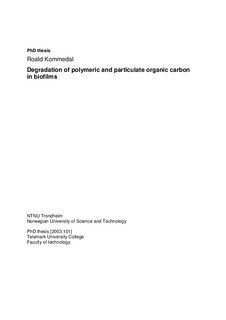| dc.description.abstract | Polymeric and particulate organic carbon (POM) are fundamental compounds in the global cycling of carbon, and constitute significant amounts of BOD in municipal wastewater.
The main objective of this work is to study molecular size effects on degradation dynamics in biofilm systems. Specifically, the effect of substrate molecular weight on degradation kinetics and transport dynamics, location of depolymerisation enzyme activity and depolymerisation intermediate formation dynamics are assessed. A mathematical model for biofilm degradation dynamics is presented, and used for data interpretation and simulations.
Dextran, an -1,6 Glucan, was used as model substrate during batch degradation in a Rototorque biofilm reactor, in addition to batch tests on biofilm sub samples retrieved from the Rototorque, and during pure endo- and exo-Dextranase studies. Oxygen utilisation rate (OUR) estimates and bulk phase TOC mass balances were used to evaluate the effect of variable initial molecular weight on the observed half order removal coefficient (Harremoës, 1978; Rittmann and McCarty, 1980). Size exclusion-HPLC analysis for determination of bulk phase depolymerisation intermediates, and specific enzyme assays were used to evaluate transport dynamics of polymers and location of enzyme activity in the enhanced mixed population biofilm system.
Dextran removal rate decrease with increasing Dextran molecular weight. The observed areal half order removal rate coefficient, k1/2,A, demonstrate an approximate 10-fold decrease in the 1-500 kDa range, showing negative logarithmic correlation to the initial MW of Dextran. A less distinct correlation is observed above this transition limit (1-10 MDa). Evaluation of the Thiele moduli, from one step depolymerisation modelling, suggests that the logarithmic reduction in observed removal rate is caused by combined reaction rate and transport limitations. Transport limitations dominates as the polymeric substrate size increase and hinders biofilm matrix diffusion, and the removal rate becomes a surface limited process. Removal of Dextran is biomass dependent in what appears to be a non-linear dependency on biofilm thickness. Expressed as biomass areal density (g/m2), no depolymerisation is observed for thin biofilms (0.7 g/m2), slow for medium (3.7 g/m2) and high for thicker biofilms (5.2 g/m2).
Depolymerisation intermediates accumulated in the bulk phase over the entire Dextran size range during pure Dexranase studies, with even size distributions. Final products were oligo-isomaltoses (DP 2-6). Dextran was not depolymerised by -Glucosidase nor Oligo-1,6 Glucosidase. During biofilm reactor and slide sub-sample tests, low MW Dextran intermediates (1-10 kDa) accumulated in the bulk during depolymerisation of 160 kDa Dextran at 250 and 200 mg/l initial concentrations, but were not detected during experiments with 100 mg/l initial concentrations. Intermediate range Dextran (10-100 kDa) did not accumulate in either case. At the same conditions, some assimilable range Dextran (0.2-0.9 kDa) accumulated in the bulk liquid during initial 250 and 200 mg/l batches, but was not detected during 100 mg/l initial Dextran concentrations. The extent of bulk phase accumulation seems to depend on the biofilm growth rate, where more bulk phase accumulation is observed during experiments with starved compared to more actively growing biofilms. More intermediates accumulate during low MW initial standards, compared to higher. These observations indicate that the extent of bulk phase intermediate accumulation is balanced by the rate of depolymerisation, and the substrate uptake rate (growth). Accumulation of intermediate hydrolysis products in biofilm systems is therefore dependent on the slowly biodegradable organic (SBCOD) loading rate.
Dextranase was detected in the cellular fraction of the biofilms. The enzyme activity was not detected in any other biofilm sub compartments, implying that the exogenous enzyme remains attached to the cells while working on polymers. These findings support the conceptual model of Confer and Logan (1998), implying that bulk phase intermediate accumulation observed in this study and by others, is not a result of enzymatic activity in the bulk phase, but transport of intermediates from the biofilm matrix. | nb_NO |
